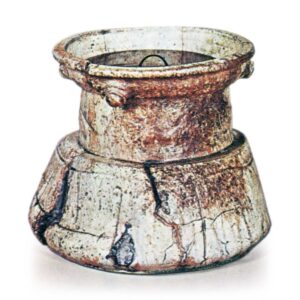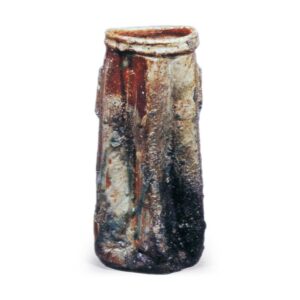

Iga ware is a type of pottery produced in Iga Province (Mie Prefecture). It was first produced in the village of Marubashira, Ayama County, in ancient times, and later spread to several villages in the area. The land borders the Shigaraki Valley in Omi Province (Shiga Prefecture), and because of the geological contact, the granite raw materials and techniques are the same as those of Shigaraki, both of which belong to the hand-thrown and Kyoto kiln styles.
History] Iga pottery was originally started to make crude farming tools while farming, and since it was not an occupational skill, it was interrupted several times. Since there was already a pottery industry in Shigaraki during the Tempyo period (729-49), it is likely that there was one in Iga as well. This ancient pottery industry merely made bottles for sacred wine and extremely sturdy farming implements and utensils. After many changes, during the Genpei uprisings, parts of Iga and Shigaraki were constantly infested with bandits, and Iga in particular seems to have been a haven for the remnants of the Heike clan, which opposed Hojo and Ashikaga and had been without a lord for several hundred years. Although it is written in a late manuscript that Iga pottery was restored in the middle of the Kenmu period (1334), no credible ancient records have been handed down, which is believed to be due to this war. In particular, the conquest of Iga by Oda Nobuo during the Tensho period (1573-92), and the great disturbances in Iga during the years before and after the conquest, forced the pottery industry here to move to Shigaraki. The chronology of the period of the pottery’s life in Shigaraki is dated to the Oei period (1394-1428) and the Kyoroku period (1528-32). Around the Kyoroku period, two men named Tarotayu and Jirotayu came to Iga to make pottery, and their successors claim them as the founders of the pottery, but none of their works are known. If the pottery of these two potters was made during the Kyoroku period, it was the late Muromachi period when the tea ceremony was finally flourishing and seed and dipping jars from Iga and Shigaraki were being converted into flower vases and water jars. It was only natural that the pottery industry was transformed from a farmer’s craft to an art or profession. In 1584, when Tsutsui Sadatsugu was appointed lord of Iga, he supervised the potters and produced elegant works that were the essence of old Iga. This is commonly known as Tsutsui Iga. The Iga pottery was revived by his son Takatsugu during the Kan’ei period (1624-44), and around that time, Kobori Enshu instructed the potters to produce tea ceremony utensils.
His works are exquisite and bear the name Enshu Iga. It is not clear who the artisan was, but it was probably Shinjiro. Shinjiro was by far the most prominent craftsman of his time, and his efforts to break the monotony of conventional techniques and create new methods were unprecedented in glaze technique, use, and conception. Takatsugu invited Magobei and Denzo, craftsmen from Kyoto, to make mainly water jars. The “Sangokushi” (Records of the Three Kingdoms) states that the works were so elegant that they became the property of the shogunate, and that the other pieces were stored in the Todo family treasury. This was the beginning of Todo Iga. During the reign of the next generation, Takahisa, a system of “Toruyama” was established to prevent the harmful effects of over-mining. Most of the early examples of Todo Iga are only water jars, not flower vases. Todo Iga imitated Ko-Iga but failed to live up to it, while Enshu Iga departed from Ko-Iga to create elaborate designs from a unique perspective, but both are far from the essence of Ko-Iga. After Takahisa’s death in 1699, the pottery industry was in a slump, producing only a few miscellaneous daily-use wares. During the Horeki era (17511-64), the feudal lord Todo Takayaku greatly encouraged and enlightened the potters, leading to a slight revival of the industry.
The seal-engraving copper seal “Iga Kuni Marubashira Seimei” is also estimated to have begun in the Horeki period. In addition to pottery of all kinds of miscellaneous wares and tea utensils, this period also produced imitations of Kutani ware, Holland ware, and Banko-yaki ware. After Takase’s death, Iga entered another period of slump, and from the Tempo period (1830-44) until the beginning of the Meiji era, Iga was stagnant and fruitless in name only. In 1923, Katsudo Kawasaki, following the model of the ancient Iga kilns, attempted to revive the old Iga kilns in Ueno Town (Ueno City), and in 1923, he established the “Ko-Iga” kiln in the town of Ueno. He started his first kiln under the guidance of Miyagawa Kozan. The main products were tea utensils, but they were not sold commercially since the purpose was to encourage art and teach potters.
The earliest Iga wares are tiles and cinerary urns, but the earliest artistically valuable ceramics are said to date from the tane jar period. Both seed pots and dipping pots were primitive farm tools, but they were discovered by tea masters and came to adorn the alcoves of kings, princes, and nobles. Most of what are now called seed pots are not true farming tools, but are from the Muromachi and Azuchi-Momoyama periods. Oto-boke (oni-boke) were originally used to hold farm women’s kamishimo (kamishimo costume), but were later converted to water jars.
Tabimakura is a substitute for a jar used to hold beans, and was so named among tea masters because of its similarity in shape to a pillow. The original farmer’s bean oil pots were small and tilted at the neck, similar in shape to tea pots, and were prized as flower vases in later times.
Kutsu-bachi, similar in shape to an ancient shoe, was originally used as a colander for sowing rice, or as a measuring cup for weighing rice and wheat, and was also used by tea masters as a pickle bowl. All of the above are said to be products of the seed pot period. Among the famous incense containers produced during the Muromachi period (1333-1573) and the rise of the tea ceremony, Kyan, mold cakes, Tsujido, and kirimochi (cut cakes) are among the most famous. Since then, potters such as Shinjiro, Kukozan, Yasuke, Sadahachi, Chojiro, Isshi, and Tokusai emerged (for their works, see the respective sections). Other imitations of works from other kilns occurred in the mid-Edo period, and the age of imitation began with Shinjiro. There were imitations of works by Nisei, Kenzan, Ko-Kutani, Oribe, Shino, and others, and the influence of the Kyoto craftsmen who came to Iga can be discerned. Some of them imitated Holland ware from the middle to the end of the Edo period, and Raku ware by Todo Zoshuinojo, Yasuke, Tokusai, and others also appeared around this time. Between Sadahachi I and Sadahachi II and III, there are imitations of Banko-yaki pottery. The fact that there are so many imitations of other kilns in Iga ware from the Edo period is a remarkable phenomenon.
The thick, powerful, curved and straight lines of Iga ware are reminiscent of Sesshu’s ink painting “Sansui” (landscape painting with broken ink). It has a majestic elegance and grand style, and is careless and unadorned. The dents in vases and water jars and the irregular shapes of stone wash basins are the result of accidental changes in the kiln, and are the subtle changes of nature, not the paintings and color tones of other kilns. The name Iga is immediately associated with pottery fired with pebbly clay, but this is the unique clay taste of Iga and Shigaraki, where most of the pebbles are feldspars with occasional silica stones mixed in. The natural distribution of these pebbles is so good that the fired pieces become stone haze and glaze. The natural elegance of this clay, without any special treatment, has a brownish flavor of its own, and the finished product is reminiscent of the beauty of a sumo wrestler’s nude body. There are many different types of Iga clay, but the one most appreciated by tea masters is the Hakudozan clay, which is baked to a pleasant reddish brown color and gives the feel of a child’s skin. This unique flavor of Hakudozan clay is not found in either Makiyama or Shigaraki, and only this type of clay can produce the blue and yellow colors that are so admired. The blue beadlo glaze was born because of this clay. Among the curvature and fineness of Iga pottery, the spatula is said to have a major role to play. The influence of the times can be discerned behind the careless blurring of the spatula, the bold and robust use of the vertical spatula, and the skillful use of the spatula. The six colors of Iga are blue, red, white, yellow, black, and purple, but most of them are produced by accidental changes in the kiln. When white or red clay turns into blackish brown due to ash fall in the kiln or other reasons, it is called “kurojoge,” or “burnt black,” and is loved by tea masters for its unique taste. In contrast to this burnt black, the so-called beadlo glaze, which is a clear and neat blue or moe yellow color on a white or pleasant red ground, is a thing of great beauty and is a masterpiece of harmony and composition. It is said that half of these are the result of the potter’s ingenuity and more than half are the result of chance. Ears and ground tea are another characteristic of Iga.
The way they are attached and the shape of the ears, large or small, can be used to estimate the period. Older pieces look as if the ears have grown out of the vessel naturally, and pieces with relatively large ears seem to be of a relatively old age. Those with ears are limited to vases and water jars. There are various types of suricha, including five or seven pieces. The beauty of Iga glazes lies in the beadlo glaze and the transparency and neatness of the moe yellow glaze, and there are various theories as to how these glazes were produced. Some say that the glaze was formed from the clay itself, some say that pebbles in the clay melted to form the glaze, and some say that the ash that fell in the kiln compounded with the pebbles and formed the glaze when it received the proper amount of firepower. Moe yellow glazes are roughly classified into white moe yellow and blue moe yellow, with white moe yellow being found in the oldest clay from the White Clay Mountain region and blue moe yellow in the oldest, thicker, blackish clay. This is a product of the Makiyama kiln.
The clay of Iga is finer in texture than that of Shigaraki, and its lively movement in the water gives it an indescribable appearance. Iga pottery is influenced by ancient bronze ware in its form, but it is often supermundane and almost unintentional. The designs of latticework and horizontal characters drawn with a finger or spatula are reminiscent of ancient Ainu paintings and have few analogues in other Japanese ceramics.
The Iga and Shigaraki kilns are closely related historically, geographically, and in terms of technique, and it is both easy and difficult to distinguish between the two.



